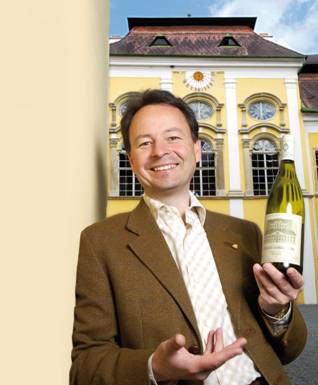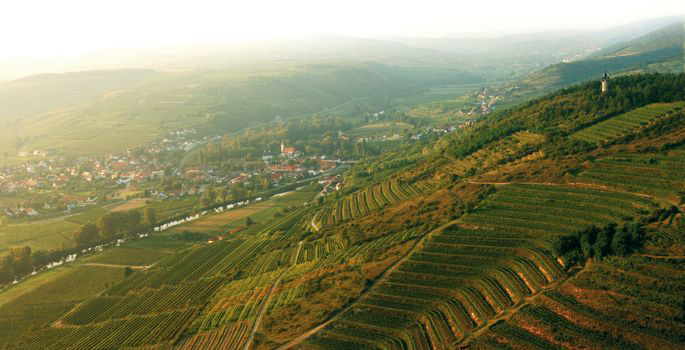[twitter style=”horizontal” float=”left”] [fbshare type=”button” width=”100″]

Wars, recessions and scandal – just a few of the things to beset the winemakers of Austria over the years. Nevertheless, we can gladly say the country has stood the test of time, now producing some of the best quality wine on the global market. Here at Wine Trust, we would like to bring you a taste of the very best Austria has to offer – so we are excited to introduce a new set of wines from the eminent estate of Schloss Gobelsburg.
As impressive as the grand estate itself with its magnificent baroque building, wine making spans back nearly 900 years to Cistercian monks at the Zwettl monastery, the monastic estate and adjoining cellar facilities that we see today coming 500 years after – in 1740. Today, after centuries at the helm the Zwettl monks handed responsibility over to Michael and Eva Mossbrugger, who have continued to build on the domaine’s rich history and venerable reputation.

Few winemakers can boost a prouder, but more turbulent, history than Schloss Gobelsburg. This historic estate has been tested by disasters of its own, such as a major fire in the 18th century and having housed French POWs in WWII facing onslaught by Soviet invaders. Surviving Nazi, Soviet and other allied occupation, the Austrian wine industry later became embroiled in a nationwide additive (ethylene glycol) scandal in 1985, which severely dented the country’s international reputation.
Of course, Gobelsberg were never party to that issue and it is testament to their total focus on quality as well as – dare we say – faith that they continued to produce high quality and authentic wines through this challenging period. Nevertheless, Schloss Gobelsburg has – sometimes quite literally – emerged from the ashes to become one of the most revered estates in the country.
Gobelsburg has always paid close attention to its practices, historically only ever using natural practices, such as organic fertilizer and abstaining from herbicides. Unsurprisingly, the estate gained deserved recognition in 1996 when it was accepted as a member of the renowned Verein der Österreichischen Traditionsweingüter (Association of Austrian Traditional Wineries), and through this association gained status akin to Premier and Grand Crus in France – Erste Lage.
A Geography lesson…

The Domaine is situated in the Austrian wine producing region, Kamptal. Vineyards cover 3,802 hectares, found in an ideal location where a number of geographical factors combine to produce an excellent array of terrior. The area is blessed climatically by the hot, Pannonian plain heat from the East and the cooler Waldviertel region in the North-West; the result, wines that possess refined aromatics and retain vibrant acidity through the combination of warn days and cool nights.
The region is partly characterized by loess and loam terraces where varieties such as Grüner Veltliner thrive, while very steep, south facing terraces lay vines exposed to underlying rock, excellent for mineral Riesling wines with huge aging potential. The region also houses crystalline sites and red felspathic sandstone, some 320-250 million years old.
The estate of Schloss Gobelsburg spans 35 hectares that sweep the grounds of the eponymous castle, each vineyard offerings its own unique soil and micro-climatic conditions. The most important grape varieties are Grüner Veltliner and Riesling. Grüner performs best – according to Michael – on soil with a mix of loess and clay. Riesling prefers the stonier and mineral soils with less clay. Over the centuries, these varieties have proven to be the most suitable for the surrounding soil structures. The Riesling feels at home on the meagre and stony terraces of Heiligenstein and Gaisberg mountain, Grüner Veltliner brings its best at Steinsetz, Renner, Grub and Lamm.
It is these two grape varieties that we bring you in our updated Austrian collection, with two Grüner Veltliner and a Riesling.
These are really exciting wines and highly expressive and satisfying. We heartily recommend them!
…
Grüner Veltliner Steinsetz Kamptal Reserve 2013

A superb single vineyard example of Austria’s home grown grape – Grüner Veltliner. Wonderful vitality, intense fruit and real style – one of the very best we have tasted in the last few years.
A single vineyard Reserve selection, Stensetz is from the Gobelsburg plateau clutered with pebbles deposited from the ancient Danube and ancient Traisen rivers during the last Ice Age. Outstanding example, 2013 Grüner Veltliner Steinsetz is a clear and aromatic classic of the variety with notes of Quince (pears, apples), white pepper powder and floral aromas on the nose followed by a full-bodied and piquant palate with notes of grapefruit and orange zest, pepper and a refreshing acidity. Very textural and layered with a long finish. Best enjoyed with food – ideal with any meaty white fish (pan fried with a lemon, parsley and butter sauce) or lemon and thyme roast chicken. Superb with a mixed plate of vegetable crudités – carrot, celery, green beans – and dips.
Grüner Veltliner Löessterrassen 2014

Spot on aperitif style of Austria’s home grown varietal – Grüner Veltliner – zesty, citric and very refreshing – perfect drinking the Spring and Summer!
Named after the Löess terraces, which are a classical feature of the Danube Valley, this wine comes from soft formed hills around Langenlois. Löess is a sandy soil – brought to the region by winds ten-thousands of years ago from the Alps. This lime soil element gives the Löessterrassen Grüner Veltliner its classical structure of elegance and his unique floral and citric character. Really lively example, zesty citric, and white pepper powder notes on the nose and palate. Very refreshing, clean and boldly fruity with particular notes of grapefruit, finishing with a lick of peppery spice. Makes a wonderful aperitif – but can also be enjoyed with lighter, spring/summer dishes such as meat, fish and vegetarian salads. Would partner new season asparagus as well.
Riesling Urgestein 2013

Another top example of this great grape – Austria’s other star varietal. Racy, citric and very fruity this is really appetising but bold enough for light food – bring on the summer!
In general Austrian Rieslings have more body and spicy notes than their German counterparts, without any loss of vitality. This primary rock (no or little top soil) Riesling comes mostly from vines less than 15 years old on the Gaisberg und Heiligenstein slopes. This is a young vine selection (12-15 years old), with the emphasis on the pure varietal and fruity character of this noble grape. A brother to the Grüner Veltliner Löessterrassen – another really lively example, fine lime zest and cordial notes, with a touch of white stone fruit. Very refreshing, clean and persistent.
Makes a wonderful aperitif – but can also be enjoyed with lighter, spring/summer dishes such as meat, fish and vegetarian salads. Has the body and grip to go well with a crab salad, slice of lime and a touch of chilli and coriander leaves.
http://www.austrianwine.com/our-wine/wine-growing-regions/niederoesterreich-lower-austria/kamptal/
http://www.gobelsburg.at/en/castle/history/timeline
[twitter style=”horizontal” float=”left”] [fbshare type=”button” width=”100″]
